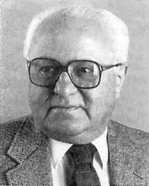Early Experiences at ABCC
by Seymour Jablon
Chief, Department of Statistics, 1960-63 and 1968-71

Seymour Jablon
How can I, in a few words, summarize nearly 30 years of history? I can’t. I can’t even mention most of the many friends and colleagues, both Japanese and foreigners, whom I have known and worked with. What I will do, then, is think back to 40 years ago, 1948, when I first heard about something called the ABCC. I had just joined the staff of what later became the Medical Follow-up Agency of the National Research Council, directed by Gilbert W. Beebe. Our offices were near those of Dr. Herman Wigodsky, who headed the staff of something called the ABCC. I knew nothing about the ABCC besides its name, but from time to time I did hear casual conversation. I remember that a crucial issue seemed to be whether Sasebo should be utilized as a control city for Nagasaki, and Kure for Hiroshima. I listened to the discussions but had nothing to contribute.
In the early 1950s a key event took place: Dr. R. Keith Cannan became Chairman of the Division of Medical Sciences, of which the ABCC and our own activity were two of the component parts. It is, I suppose, no secret that in those years some thought that the ABCC had lost its way. The reason for this seems clear in retrospect: The studies required were primarily epidemiological and biostatistical, while ABCC had been directed and its program organized by medical scientists mostly from the disciplines of medicine and pathology. In the late 1940s, it should be remembered, little was known about the late effects of radiation. Some thought that specific ill effects, pathognomonic of radiation, might be observed; none were seen. In 1955, unwilling to concede that the program was a failure, Dr. Cannan persuaded Dr. Thomas Francis, Chairman of Epidemiology at Michigan, to lead a small group charged with reporting on the state of the ABCC program, and, if possible, prescribing remedies. Felix Moore, who headed the biostatistics program at the NIH National Heart Institute was a second member, and I was fortunate enough to be asked to join the team.
We visited Hiroshima in November. I had never been to Japan before, and the experience was overwhelming in its impact on me. Although much rebuilding of the city had already taken place, there was still much evidence of destruction. In a hectic 10 days, the three of us informed ourselves, as well as we could, of the state of the program and set down on paper a specific plan of action that became known as the Francis Report.
The Francis Report prescribed what was to be done; equally important was who was to do it. The principal part of the work would have to be done by Japanese. However the disciplines of chronic disease epidemiology and biostatistics at that time were still primitive in the United States and even less well developed in Japan.
Moreover, it proved almost impossible to find ways to bring Japanese scientists to ABCC without penalizing their university careers. It was necessary to bring scientists from the United States. A key to solving the problem was an arrangement by which the departments of pathology at UCLA and of medicine at Yale agreed to staff the corresponding ABCC departments. Gilbert Beebe agreed that our group at the National Research Council would be responsible for statistics. The final element in the reconstruction of the ABCC was obtaining long-term expert direction from Dr. George B. Darling, then a professor in the Yale School of Medicine. In the years that followed, Gilbert Beebe and I each spent six years at ABCC and saw the organization grow from a tender plant with uncertain prospects to its present situation, as RERF, one of the premier epidemiological institutions in the world, and certainly the primary source of information about the effects of radiation on man.
This article was originally published in RERF Newsletter 14 (40th anniversary special issue): 36-37, 1988

